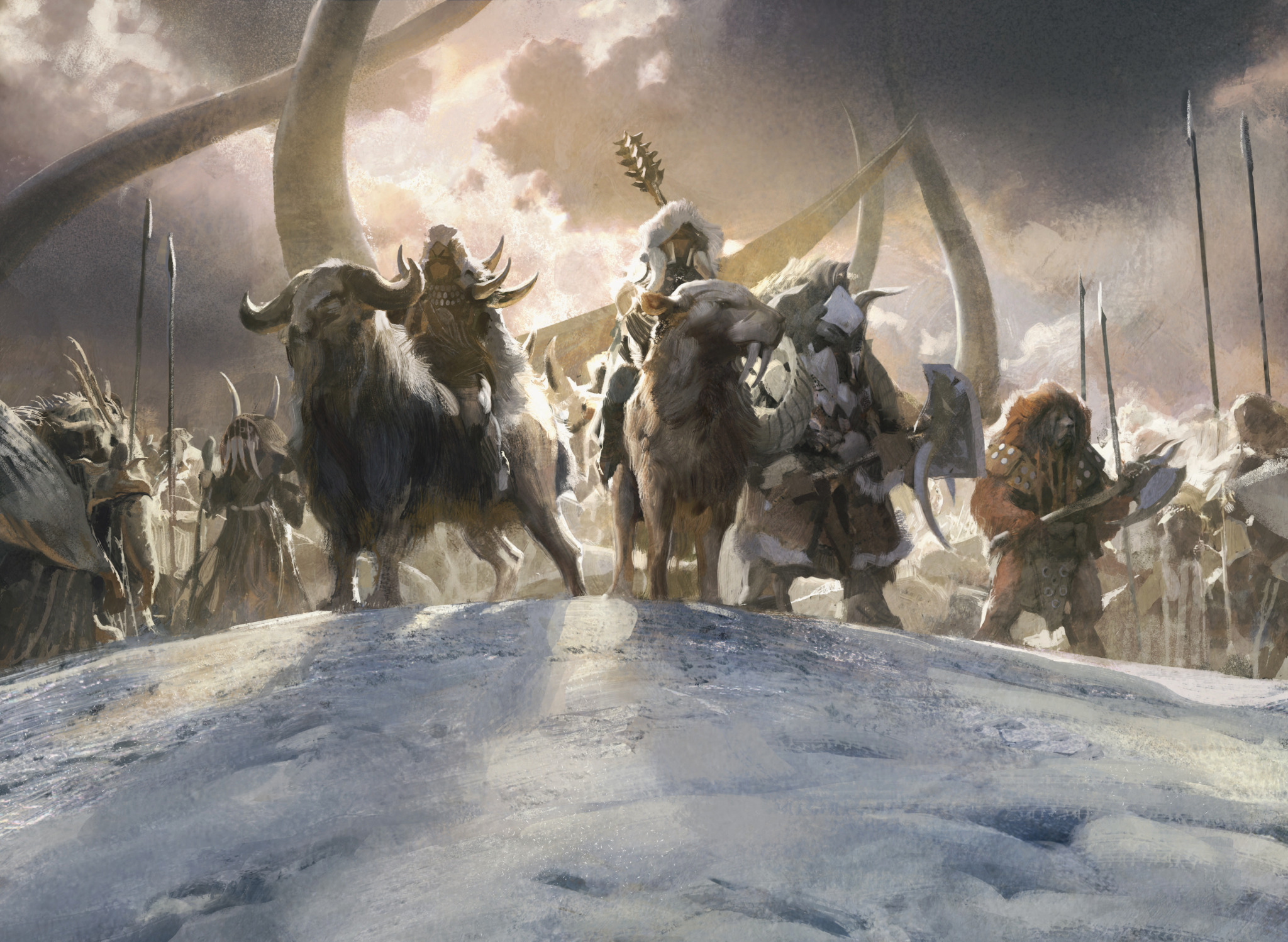Temur Frontier
"If hard work and a prosperous hunt are not enough for our way of life, then we will do what must be done. If bones must break to protect my people, then they will break."
- Surrak Dragonclaw
Structure
The Dragonclaw. This was the official mantle of clan leadership, a title conferred through feats of battle, but which sometimes was earned or defended in ritual challenge—usually a wrestling bout. The title could be held by anyone who can take it, regardless of age or gender.
First Father or First Mother. The highest-ranking member of the clan was considered the parent of all members. Sometimes, but not always, this role was also filled by the Dragonclaw. The First Father or Mother had no spouse, but traveled with other families and shared their encampments.
The One Who Whispers Twice. While Temur shamans generally lead a hermetic existence, one was selected to be the clan advisor. This person, called the One Who Whispers Twice (once to the spirits and once to the Dragonclaw), traveled with the leader and his or her family instead of spending a life in solitary meditation, to guide the clan along the best path. This person provided military intelligence gleaned through magical divination and communication with spirits, warned of potential attacks, foresaw the best grounds for hunting and raiding, and lead the summoning of ancestral troops in times of great need. He or she could initiate the Wide Whisper to consult with the other shamans when the need arose.
The position was held for life. Whisperers did not compete for the role. Rather, it was seen as a sacrifice, giving up the pure life of communing with the spirits to deal with temporal issues. The whisperers would convene at the sacred meeting place of the Dragon's Throat.
Each shaman whispered to one spirit, either elemental or ancestor, and the spirits decided on the most worthy choice. As compensation, the chosen one was able to commune psychically with not only other shamans, but with the frozen ancestors as they slept (rather than first embodying them as ice doubles).
Hunt Caller. This person was responsible for the clan's pursuit of food animals, directing each family group to handle a particular area. He or she would also command raids against neighboring clans to seize supplies. The mantle of Hunt Caller could be held by anyone. It was earned rather than conferred, during the night of the Great Hunt. The hunter who brought back the greatest number of beasts, or the most formidable opponent, gained this title for the next year. The Hunt Caller was usually human, although ainok would sometimes hold this position.
Culture
"Wandering bears." The Temur were nomadic. They traveled in small family groups, pursuing herd animals and settled temporarily in areas where food was plentiful, such as thickets of berry bushes or streams full of fish. In this, they resembled the bears they revere. Only in the harshest months of winter would they cease their wandering.
Wandering Temur carried everything they needed with them. Their fur-lined coats, mittens, and heavy hide boots were effectively houses they always inhabited. Lightweight shelters of scraped hide could be quickly set up to block wind and precipitation; dragon bones were readily available for use as tent poles. In areas of deep snow, they made use of sledges, which they hauled themselves. These carried bundles of clothing, extra weapons, traps, dried food, and other supplies. Otherwise, they packed gear on their backs. Trusted ainok warriors sometimes helped them carry their supplies.
Families within a family. Family was central to Temur thinking, almost as important as it was among the Abzan. The bonds within a family group and to the family leader are much stronger than those were to an external leader. Each family group saw the others as siblings within the community and supported them in the same way (although one's own family always cames irst). The First Father or Mother of the clan was considered to be the parent of all the families, and they owed fealty to the khan as they would their own parents. Every adult member of the clan was a formidable fighter, and children learn weapon-play early in life. Even a nursing mother was a ferocious opponent in battle, perhaps even more so than others since she carried infant with her and would fight ceaselessly to protect it. Shamans are seen as living links to the ancestors who are frozen in time.
Disbandment
Yasova surrendered to Atarka after placating her with fresh food. Demonstrating that she and her followeres were more useful alive than dead.
Mythology & Lore
Whispering. Temur spirituality was highly shamanistic, with a strong elemental flavor. Shamans called their magic "whispering" and spoke of the frozen memories and even the frozen spirits of the ancestors. Many Temur had an elemental affinity that allows them to shape stone and ice to varying degrees. Those with the strongest talent constructed fortified cave shelters and manipulated the terrain in battle to hinder the enemy and strengthen their own position.
The Wide Whisper. The clan's chief shaman would be able able to enter a trance communion with all of the other shamans, regardless of distance. Through this, the chief shaman exchanged information and, when a mighty summoning is needed, could lead a "wide whisper" that involved the whole group. Such powerful rituals can awaken a very ancient ancestor or raise up a mighty elemental spirit.
Tenets of Faith
The past is with us. Shamans spoke of "frozen memories," but every Temur lived simultaneously in the days of the ancestors and in the present. Clan roles were believed to be eternal, with each new generation assuming the ongoing mantle of a role: hunter, leader, whisperer, nurturer, slayer, and so on. Clan legends spoke of these roles rather than named heroes.
Priesthood
Isolated Shamans. Temur whisperers were sometimes known as the "weavers of the three destinies," referring to the past, the present (which they call "the now,"), and the future (called "the unwritten now"). They are far more aware of the continual and overlapping nature of time than ordinary Temur, seeing the past and the various possible presents all at the same time. They wear enormous headpieces that completely shade their upper faces. From these they hang fetishes and charms made from carved bone, antlers, relics, and the like. The assemblage serves to focus the shaman's whispering; the more tokens, the more powerful the ritual. On the oldest shamans, such heavily decorated headgear bows the wearer's shoulders.
Their eyes are never visible, symbolically reinforcing the idea that they whisper and listen to the ancestors and the elemental spirits, and see all times. They are by no means helpless; they move about unassisted and apparently are completely aware of their surroundings, although it's unknown to others whether this is magically assisted sight, augmented senses other than sight, or psychic sensitivity. The shamans do not explain themselves.
DISBANDED/DISSOLVED

Type
Geopolitical, Clan
Successor Organization
Leader
Location
Related Ranks & Titles
Related Professions
Manufactured Items
Notable Members
Remove these ads. Join the Worldbuilders Guild



Comments